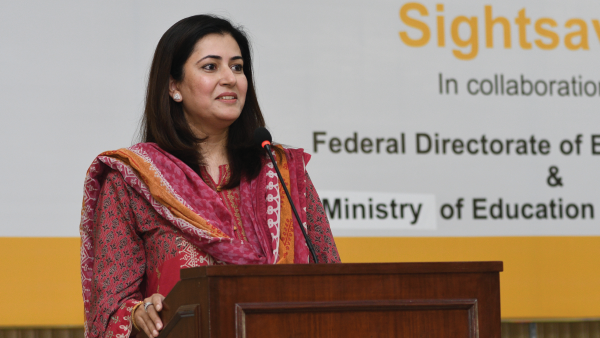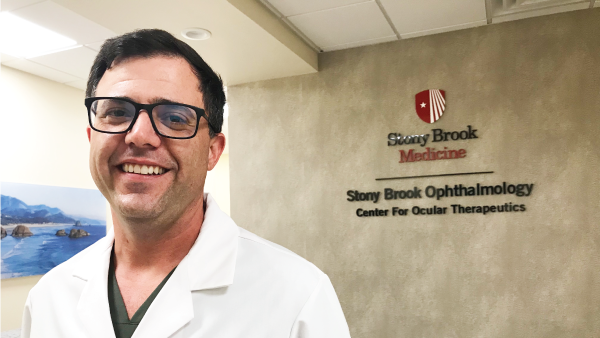You are viewing 1 of your 3 articles before login/registration is required
Breaking New Ground
James Loughman, co-founder and CEO of Ocumetra, outlines the company’s innovative tech-based approach to myopia management
Ocumetra is a data analytics company founded by James Loughman and Ian Flitcroft. The company’s mEYE Guide and mEYE Gauge solutions both help address barriers to myopia management. First, mEYE Guide acts as a starting point for myopia management and a web-accessible parent communication tool that is designed to increase uptake and retention of myopia management – all while maximizing chair time. Second, mEYE Gauge provides a mathematical model to approximate axial length using routine optometric measures, and is the only such tool to factor age and sex into the approximation and thereby deliver unparalleled accuracy in axial length estimations. Such accuracy allows eye care professionals to identify children with a greater than normal axial length – a risk factor for both myopic progression, myopic complications and vision impairment.
We caught up with James Loughman to learn how Ocumetra evolved from initial academic research conducted by the co-founding pair at the Centre for Eye Research Ireland to a company making a splash in the myopia management space.
How did Ocumetra come about?
The Centre for Eye Research Ireland (CERI) is based at the Technological University Dublin, which, like all universities, has a commercialization department – a technology transfer office to assist the translation of research ideas into innovative products on the commercial market. The university supported us with our initial IP filings and then they helped us establish Ocumetra, a company with a real desire to solve some of the barriers to comprehensive myopia management – patient communication challenges in particular.
We then spent a year designing our proof-of-concept tool and exposing the tool to major stakeholders in myopia management. We got extensive and generally very positive feedback on this from parents, from clinicians, and from industry partners. Some of the critical feedback was particularly useful in helping us refine the product into our current digital, web-accessible platform which is designed to help clinicians deliver simple, effective myopia management without compromising their chair time. Just as “every dioptre matters” for successful myopia management, “every minute matters” for ECPs at the coalface of everyday clinical practice.
Can you outline how Ocumetra’s products help clinicians?
Our software provides an easy way into the myopia management journey by taking away the pressure of the decision-making component. Clinicians have many questions: Who do I treat? When do I start treatment? When do I stop treatment? And when patients are on treatment, clinicians need to ask: Is this treatment working or not? How do I know if they’re progressing more or less than expected for their age, sex and ethnic background in terms of their axial length or their refraction?
mEYE Guide is designed to help clinicians at every stage of their myopia management journey, All clinicians need to do is to quickly enter some basic patient details and their refraction. Based solely on this information, a detailed, personalized report is generated, which outlines the child’s individual risk profile and the benefits of myopia management. Centile charts allow us to show how each child’s refraction compares to other children of the same age and sex, and to predict what level of refraction the child will reach by age 20 without myopia management. This is a powerful tool for parents who are myopic themselves and understand the impact of myopia on their quality of life. mEYE Guide’s vision simulation takes things a bit further and illustrates the impact of a child’s current and predicted adult refraction on their vision. It resonates particularly strongly with parents who are not myopic themselves – who don’t really understand what it means to be shortsighted. Other features in the software illustrate the long and short-term benefits of myopia management, how treatment reduces the likelihood that the child may need stronger glasses over the next year and how treatment can dramatically reduce the risk of eye health complications over a child’s lifetime. There is additional information about what treatments are available, the pros and cons of each treatment, as well as lifestyle tips for parents to improve their child’s outcome. The mEYE Guide report is instantly shareable with parents via QR code, so they get immediate access to their child’s personalized myopia management report on their phone. We have also made it easy for both parents and eye care professionals to be able to access information about the science behind what we’re doing.
mEYE Gauge tackles the axial length issue. If you’re not measuring axial length, you should be estimating it as this can provide valuable additional information on a child’s risk or vision loss due to myopia. While other tools don’t take all the necessary information into account, our machine learning tool is useful for identifying high-risk children – those who have a much longer axial length than you’d expect (even for their level of refraction and age), and for clinicians learning how to incorporate axial length into their myopia management routine, without the expense of biometry in the early stages.
We’re about to launch our next version of mEYE Guide, which will include measured axial length capabilities. You’ll be able to input an axial length measurement into mEYE Guide and get enhanced information about what this axial length means and the likely outcome of treatment.
What are the main challenges around myopia and communication?
When we talk to clinicians, they still say communication is the key barrier. Talking to parents, explaining new therapeutic concepts, and convincing them that these expensive treatments are necessary – or at least a good idea – for their child is a challenge. There is a growing level of awareness around myopia, but much of it is industry-driven. And that’s where we at Ocumetra, with our backgrounds in academia, bring a level of scientific credibility. Even though we’re in the commercial space now, we’re entirely focused on delivering better health outcomes. In fact, it is our key motivation as a company.
Many stakeholders are responding in a really positive way to our solution; for example, we’re seeing strong interest from some of the larger optical chains, who want to standardize their approach to myopia management. As with any new technology, there are early adopters who will do anything to get on board with the latest innovation and there are those who move a little bit more slowly – perhaps still figuring out the best approach to myopia management.
What is the longer-term outlook for Ocumetra?
As well as the advanced version of mEYE Guide, which will be available shortly, our next tool will have the ability to track change over time. What we have now is really good for the initial conversation, getting people on board and accepting myopia management as their preferred option. What we need now is a solution that keeps them on board in six months and 12 months’ time when there’s perhaps an increase in the patient’s prescription or axial length. In such a scenario, which is highly likely for most children on treatment, it is crucial to be able to show and convince the parent that the treatment is working despite progression. Only then will parents stick to the treatment for the length of time necessary to achieve the full health benefits for their child. Similarly, the tool will show ECPs when treatment is not working sufficiently, necessitating a change in treatment or compliance to treatment. We want to break down the efficacy of treatment into a single number and chart, so clinicians can see straight away in a graphical and numerical format how well each child has responded to treatment.
We have lots more planned to better assist clinicians with our innovative software platform, intuitive infographics to get parents and patients on board with myopia management without the need for lengthy difficult conversations. We look forward to working with clinicians to ensure we best serve their needs.
The New Optometrist Newsletter
Permission Statement
By opting-in, you agree to receive email communications from The New Optometrist. You will stay up-to-date with optometry content, news, events and sponsors information.
You can view our privacy policy here
Most Popular
Sign up to The New Optometrist Updates
Permission Statement
By opting-in, you agree to receive email communications from The New Optometrist. You will stay up-to-date with optometry content, news, events and sponsors information.
You can view our privacy policy here
Sign up to The New Optometrist Updates
Permission Statement
By opting-in, you agree to receive email communications from The New Optometrist. You will stay up-to-date with optometry content, news, events and sponsors information.
You can view our privacy policy here







